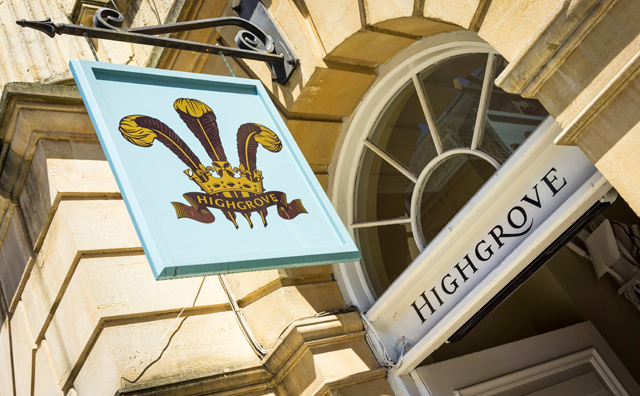Royal retail therapy: The Highgrove Shops
The Highgrove Shops, at The Prince of Wales’s country home, nearby Tetbury and online, are doing a roaring trade. Paula Lester meets six of the British craftspeople contributing to their success


Ever since the Duchy of Cornwall purchased the Georgian house at Highgrove in 1980 as a country residence for The Prince of Wales, his affection for the area has stood the Cotswolds in good stead. Chosen as an ideal base for The Prince, thanks to its easy links to London and the rest of the country, as well as the Duchy properties in Wales and the South-West, Gloucestershire must have also made sense due to being in Beaufort hunting country and the proximity of local polo clubs.
However, it is the gardens surrounding his home, which The Prince—with help from the Marchioness of Salisbury, Rosemary Verey, Miriam Rothschild and Sir Roy Strong—has restored over the past 34 years, along with two Highgrove Shops, that have been the biggest draw for many horticulturalists and tourists.
Each year, approximately 40,000 people join pre-booked, escorted tours of what His Royal Highness hopes ‘has gradually become a garden which delights the eye, warms the heart and feeds the soul’. And, as The Prince admits in the guidebook, the decision to open a shop at the rear of the Orchard Room— a handsome function room constructed in 1998 from Cotswold, Bath and Guiting stone—was prompted by these visitors: ‘After your garden tour, I hope that you may take the opportunity to visit the Highgrove Shop. This was established in response to requests from visitors to be able to take away a souvenir of their visit.’
Encompassing a fascinating walk through 15 acres of the organically managed grounds that envelop the house—previously owned by Maurice Macmillan, the Tory MP and son of Harold Macmillan, the former Prime Minister—the tour explores a series of gardens, such as the stumpery, the wildflower meadow, the walled garden and the dazzling Carpet Garden, for which The Prince won a silver gilt at the 2001 RHS Chelsea Flower Show.
In the recently published Highgrove: A Garden Celebrated, which His Royal Highness co-wrote with Bunny Guinness, The Prince comments: ‘Some may not like it, others may scoff that it is not in the “real world” or is merely an expensive indulgence. Whatever the case, my enduring hope is that those who visit the garden may find something to inspire, excite, fascinate or soothe them.’
This is, no doubt, a sentiment that he, and the Highgrove Enterprises team, aims to emulate via the carefully chosen items for sale in the shop. Only accessible at the end of the garden tour, the shop on the estate, like the larger store in nearby Tetbury that was opened by The Prince and The Duchess of Cornwall in 2008, seeks to stock unique products for home and garden, made by skilled craftspeople using traditional methods.
Both stores sell an array of organic, Highgrove-branded foodstuffs that are also available at Fortnum & Mason in London. All profits, from the garden tours and the shops, are paid to The Prince of Wales’s Charitable Foundation, which was set up in 1979 and supports a range of causes by giving them grants.
Exquisite houses, the beauty of Nature, and how to get the most from your life, straight to your inbox.
All products, inspired by the house and garden at Highgrove, as well as the personal interests of The Prince of Wales and The Duchess of Cornwall, must meet rigorous buying criteria, in that they have genuine provenance, are of original design or formulation and have been sourced responsibly with regard to environmental issues. This is a set of benchmarks that these six craftspeople pass with flying colours.
Two-hour guided tours of the gardens at Highgrove can be booked from April to October, from £24.50 per person (020–7766 7310; www.highgrovegardens.com). The Highgrove Shop at 10, Long Street in Tetbury is open Monday to Saturday, 9.30am–5pm, and on Sundays, 10.30am–4.30pm (0333 222 4555; www.highgroveshop.com)
THE HIGHGROVE SHOP CRAFTSPEOPLE
The soft-toy maker
‘Highgrove came to us as we’re Britain’s only remaining teddy-bear manufacturer and we make everything by hand from start to finish,’ says Sarah Holmes of Merrythought (01952 433116; www.merrythought.co.uk), a family-run business that’s been producing teddy bears and other charming soft toys from its factory in Ironbridge, Shropshire, since 1930.
‘It’s very good at sourcing high-quality goods for its shops—and we know His Royal Highness is a great supporter of British-made, ethically sourced goods— so every product we make for the shops is designed exclusively for them and is therefore unique,’ adds Sarah, 30, a former PR and recruitment consultant, who, with her sister, Hannah, 33, an erstwhile chartered surveyor in London, took over the firm after their father, Oliver, died from cancer in 2011.
For Sarah, the ‘standout item’ from this year’s collection is the adorable antique gold mohair Highgrove baby bear that’s part of the children’s range. ‘It has The Prince’s crest of three feathers embroidered on the left paw pad, which is very sweet, as are the hedgehog and bunny soft toys we make for the shops,’ she enthuses. ‘We also make a higher-end, limited-edition teddy bear called Carrick, which was personally chosen by His Royal Highness in terms of design and has almost sold out,’ says Sarah. ‘Every toy that’s offered for sale is, at some point, seen by The Prince—it’s always reassuring to know everything’s been given a royal seal of approval.’
The savoury preserves maker
‘We were all foodies way before the word was even invented,’ says Guy Tullberg of Tracklements (01666 827044; www.tracklements.co.uk), the traditional savoury preserves company established by his father, William, in 1970. Based near Malmesbury in Wiltshire, the condiment connoisseur employs more than 40 people making up to 60,000 jars of more than 60 different types of mustards, jellies, ketchups and chutneys each week and began working with Highgrove when the Duchy Home Farm started growing mustard for the company.
‘Once, when I was inspecting a field of mustard, I felt two Jack Russell terriers sniffing my legs and The Prince of Wales appeared and said “doesn’t it smell wonderful when it’s in flower?”,’ recalls Guy. Then, the head gardener asked whether Guy could make use of any leftover produce and a crab-apple jelly recipe was devised.
It’s still sold in the shops, but the range has since expanded to include 11 products, from beetroot chutney to tomato relish and damson jelly. ‘We’re very proud of what we do,’ adds Guy, whose preserves can be purchased at Waitrose, Booths and 1,200 independent retailers.
Stressing the importance of good ingredients, such as British horseradish, Aspall cider vinegar and Maldon sea salt, Guy believes in taking time to perfect recipes, not least cooking and caramelising each batch of onion marmalade for three hours. ‘We want to make a product that’s as good as homemade and The Prince sees that enthusiasm,’ he adds.
The Victorian pottery
‘Highgrove Hens [an earthenware collection featuring The Prince of Wales’s black Marans and brown Welsummer chickens] was the first range we developed,’ says Richard Eaton, design director at Burleigh (01773 740740; www.burleigh.co.uk), which has been making crockery near Stoke-on-Trent, Staffordshire, for more than 160 years.
With the endearing hens collection continuing to fly off shelves, Highgrove asked the UK’s last surviving Victorian pottery— where an 80-strong workforce is still able to produce wares thanks to a £9 million grant from The Prince’s Regeneration Trust that saved it from closure in 2011—to come up with another collection. ‘We were after a quintessentially English design that would evoke a great summer’s day when all you want to do is sit outside and have a cup of tea and a slice of cake,’ explains Richard.
So, working again with Samantha Buckley, who had so successfully captured the hens on ceramics and whose style involves applying thousands of tiny, onehaired brushstrokes to create great depth of colour, Burleigh devised a range decorated with delicate botanical illustrations of meadow flowers.
Once the designs by the former student of The Prince’s School of Traditional Arts had been approved by His Royal Highness— ‘it was a real collaboration’—Burleigh named the line after The Prince’s Coronation Meadows project, which aims to establish one wildflower meadow in every county. ‘We fell in love with Samantha’s watercolours straight away,’ admits Richard. ‘The dainty pink, yellow and blue flowers have been painted with an attention to detail that gives each piece great character.’
The ceramicist
Inspired by the ‘spontaneity of the brushwork and the calligraphy’ in the English Delftware she has admired since unwittingly buying an antique serving plate for just 50p when she was an art student, Deborah Sears now makes her own exquisitely hand-painted, tin-glazed pottery in a studio in Horton-cum-Studley, Oxfordshire, situated near the River Thames, known locally as the Isis.
Taking its name as inspiration, the Americanborn artist established Isis Ceramics (01865 358000; www.isisceramics.com) in 1988. ‘Highgrove is a great pleasure to work with,’ says Deborah. ‘I knew His Royal Highness was aware of my work, but I was delighted when I was asked to make a suggestion as to a range that could be sold in the shop,’ she continues. ‘I visited several times, but wasn’t allowed to take a camera, so I sketched everything.’
Deborah created a series of limited-edition pieces, including a green wigstand jar, a ginger jar and a large serving bowl, in a range of patterns and shapes that evoke the genteel spirit of 17th- and 18th-century England. ‘It’s a garden that’s profoundly layered with meaning. I just love the way the house is surrounded by the wildflower meadow, because it shows the rhythm of the year— it’s like a wonderful timepiece,’ attests Deborah. ‘I hope my collection gives a sense of how thoughtful that garden is.’
The willow sculptor
Now occupied full-time creating striking, lifesize willow and wire animal sculptures at her studio on the fringes of Whitby in North Yorkshire, Emma Stothard (01947 605706; www.emmastothard.com) might never have got going at all were it not for a grant from The Prince’s Trust. Eschewing her career as an art teacher to follow her ambition to weave willow, the money allowed Emma to buy withies from the Somerset Levels, invest in some tools and pay her rent. More importantly, she adds, the cash came with regular visits from a bank manager, who imparted valuable business advice as well as the affirming knowledge that ‘someone believed in me and what I wanted do’.
The following year, Emma wrote to ask if she could make The Prince a sculpture, using willow from Highgrove, as a thank-you gift. ‘Clarence House replied saying His Royal Highness had chosen for me to make a sculpture of Tigga [his much-loved Jack Russell terrier, who died in 2002 at the age of 18],’ says Emma. ‘I used different coloured willow for the patches on his coat and The Prince was delighted with it.’
More recently, Emma has been invited to exhibit a number of pieces on the Orchard Lawns at Highgrove, including Clarence, an Irish moiled bullock, hens, Cotswold sheep, hares, roe deer and Gloucester Old Spot pigs. ‘I try to capture a moment with an animal,’ explains Emma, who has an uncanny knack for bringing her subjects to life, whether it be through myriad strands of willow, mild steel, sterling silver, copper or phosphorous bronze wire. ‘I often have to tape up my fingers when working with wire and decent hand cream is a must,’ she admits.
The textile designer
A former furniture designer for John Lewis, DFS and Feather & Black, Victoria Sangwine- Gould has been running her textiles business (01453 751886; www.studiovee.co.uk), tailoring handmade cushions and interior and fashion accessories from recycled, reclaimed, designer and vintage fabrics, since 2010.
Based at Stafford Mill on the outskirts of Stroud in Gloucestershire, Victoria spends her days dreaming up and machine sewing all sorts of wonderful creations, from jewel-bright velvet make-up bags to iPad covers made from pinstriped suit fabric. Once she’s chosen a material, Victoria draws and cuts paper templates before sewing a single stitch. ‘I take a lot of pride in the quality of the finish,’ insists Victoria. ‘I want to make products out of material that’s already had another use, but I want them to be beautiful.’
This is especially true when endeavouring to appeal to a customer base as discerning as Highgrove’s. After a Highgrove Enterprises buyer spotted Studio Vee at Westonbirt Fair, Victoria was invited to develop a set of one-off cushions for the shops. ‘We settled on a green-check appliqué pheasant motif (left), made from The Prince of Wales’s green-check wool, and cutouts of Highgrove’s Wildflower Meadow print in the shape of robins and wrens.’
* This article was first published in Country Life magazine on September 17 2014 * Follow Country Life Magazine on Twitter
